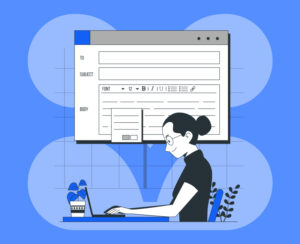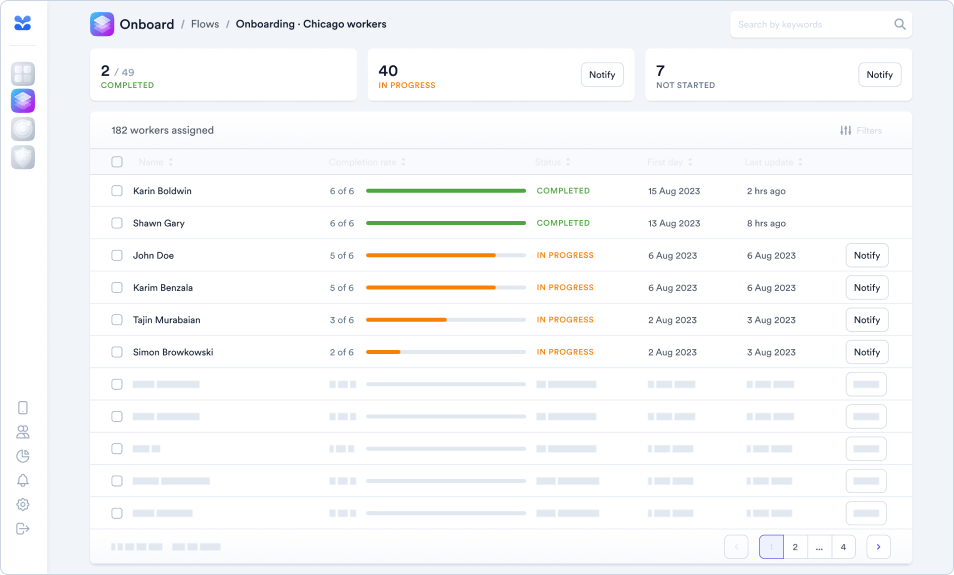Have you made a point to invest time and resources in your employee onboarding process? If not, you’ll want to listen up!
A successful employee onboarding process can have meaningful outcomes for the longevity of your workers—the more prepared and engaged they feel before they begin, the more likely they are to stay on staff for the long term. This crucial step in the overall hiring process can help your new team members feel motivated, excited, and ready for their first day.
In this blog post, we’ll explore the rubric for a successful employee onboarding process, explain why it should be a top priority for hiring managers, and how to put real tasks into action.
What is employee onboarding?
Once you’ve extended the job offer to qualified candidates and they accept, the onboarding journey begins. The employee onboarding process typically does not end until a few weeks or months into the new hire’s tenure.
The purpose of the onboarding process is to acclimate your new hires to their new role. First and foremost, they need to complete all required paperwork and submit it to your hiring team. They also need to provide credentials (if applicable), proof of identity, and any tax forms.
But beyond paperwork, the onboarding process is also a time when new hires are informed of company policies and procedures, job duties, expectations, and what is considered success at their new company. Hiring managers should focus their efforts on ensuring their new hires feel connected, informed, and ready to transition to their new roles.

Onboarding vs. orientation
Contrary to the orientation period, onboarding begins before new hires actually start work. Onboarding is a series of procedures and processes—some of which are legally mandated—whereas orientation is typically a scheduled process that happens during the new hire’s first few weeks on the job. Orientation is typically more hands-on and involves the new hire getting acquainted with their daily job duties and coworkers.
See how Fountain Onboard can get your workers up and running fast and cost-effectively.
The importance of an onboarding strategy
Creating an employee onboarding strategy is of the utmost importance for getting workers up to speed, in your systems, and ready to work. An effective onboarding strategy can result in the following benefits.
- Improved employee engagement. A candidate-first onboarding process helps new hires feel like they’re part of the team before they even start. This can translate into more engaged and productive workers.
- A faster hiring funnel. A swift onboarding process decreases the time between a new hire accepting an offer and their first day on the job. The faster you can get new hires ready, the faster the greater hiring funnel becomes.
- Improved employee retention. When employees are part of a structured and organized onboarding process, they’re more likely to see the organization as one that invests in and cares about their employees. This can have a direct impact on retention rates.
- Decreased talent acquisition costs. When an onboarding process is designed well and functional enough, this reduces the risk of errors which can lead to worker drop-off and force hiring teams to dip into their budget to source more applicants.
If you’re stuck with an inefficient employee onboarding process, you’re at risk for poor candidate engagement, which may cause new hires to drop out of the process and not show up on day one. This can have the opposite effects of the benefits listed above, such as a slower hiring process and increased hiring costs.
Key steps in the employee onboarding process
To achieve an efficient employee onboarding process, see below for the essential steps to help you prepare new hires for their first day on the job.
- Documentation—If certain documents weren’t collected during the application stage, you’ll need to prepare the proper paperwork that new hires must review and sign before they can start working. These forms might include an I-9, W-4 tax form, and direct deposit forms.
- Logistics—To ensure the new hires are informed and have access to everything they’ll need to be successful, you’ll need to add them to a company-wide email list, give them their ID card or access key/fob, and help them arrange parking and transportation.
- Communication—Before your new hires start their new role, send an email or text message to them to reiterate your enthusiasm and provide them with all the crucial info they’ll need for their first day.

- Orientation—During their first week on the job, arrange for them to meet their manager, and team, and get acclimated to their new work environment.
- Training—To foster career growth, set up ongoing training sessions to keep their skills sharp and offer opportunities for upskilling.
- First three months—Once your new hires have completed their first three months, make a point to meet with them and review their progress thus far. Offer them the opportunity to ask questions and set goals for the next six months.
- First six months—At six months, take time to recognize your new hire’s achievements, outline a career development plan, and review their previous goals.
Get more onboarding tips, including access to our comprehensive checklist.
Problems that harm the onboarding process
These tasks might all seem simple enough, but what happens when common onboarding roadblocks get in the way? What do those roadblocks even look like?
- Lengthy onboarding cycles. Existing onboarding processes for frontline workers are long, arduous, and not always clear for the new hire. These tasks can cause new hires to feel frustrated, overwhelmed, and disengaged before they start the job.
- Generic onboarding materials. Generic onboarding materials can leave new hires feeling like they’re just a number. And when you’re trying to build a top-performing team of loyal workers, you want them to feel like a valuable part of the organization.
- Limited resources. Managers and recruiters already are stretched thin, which is precipitated even further by manual onboarding processes. Poor onboarding efforts can result in misinformation and miscommunication, and can cause new hires to feel lost and unseen.
How to build a better employee onboarding process
If you find yourself deterred by the obstacles above, here are a few tips to building a better process.
- Develop a strategic plan. Onboarding can be a huge time drain for hiring teams, especially those with limited resources. A strong and clear plan will make sure everyone is on the same page.

- Customize your onboarding process. Present candidates with a personalized experience that aligns with their new employer’s culture and values by customizing the onboarding process through branded task dashboards and chatbots.
- Track and analyze to optimize for success. Customized dashboards allow visibility into onboarding workflows and individual onboarding journeys, allowing you to make changes to improve processes.
How AI elevates the onboarding process
With AI-powered technology, hiring managers can rely on automation to take care of manual tasks. AI capabilities can help accelerate onboarding and eliminate the need for manual recruiter involvement. This allows hiring managers to delegate tasks and recruiters to focus on making sure new hires feel welcome and are ready for their first day.
Future-proof your employee onboarding process with Fountain Onboard
A rapid onboarding process results in enhanced productivity elsewhere in the hiring funnel. Fountain knows this, and that’s why we’ve built Fountain Onboard, an easy-to-integrate solution that keeps candidates informed and engaged throughout the entire process.
Fountain Onboard creates the opportunity for increased retention rates by ensuring candidates are aligned with company values early on, which makes them more likely to become motivated and committed team members. A personalized task dashboard and mobile portal feature a branded interface that helps create a consistent experience for new hires. This feature also helps enhance new hires’ sense of belonging before they even start their first shift.
With these features and more, Fountain Onboard can help reduce drop-off rates while ensuring your new hires are set up for success from day one.
Read more about Fountain Onboard and learn how to make it a part of your hiring process.

